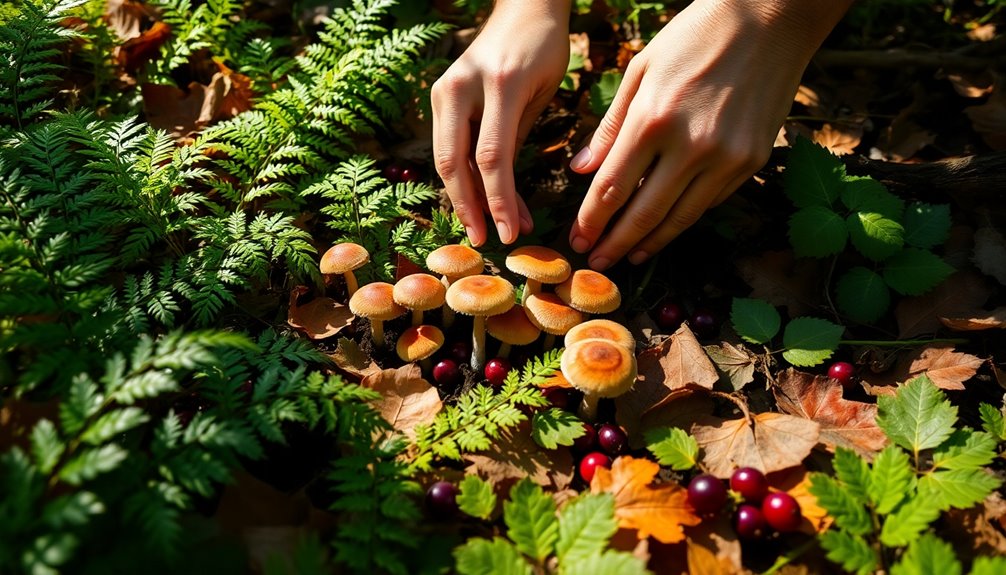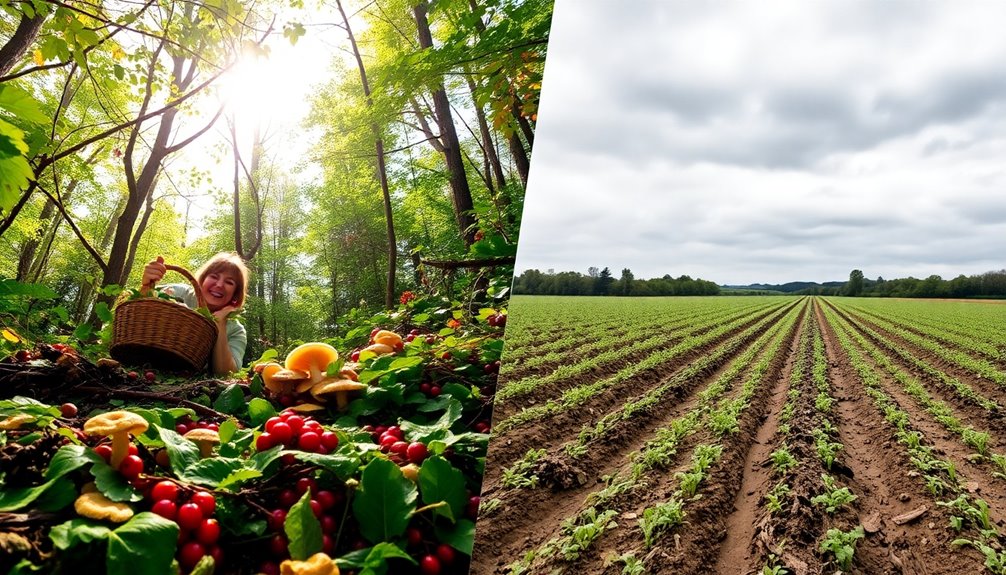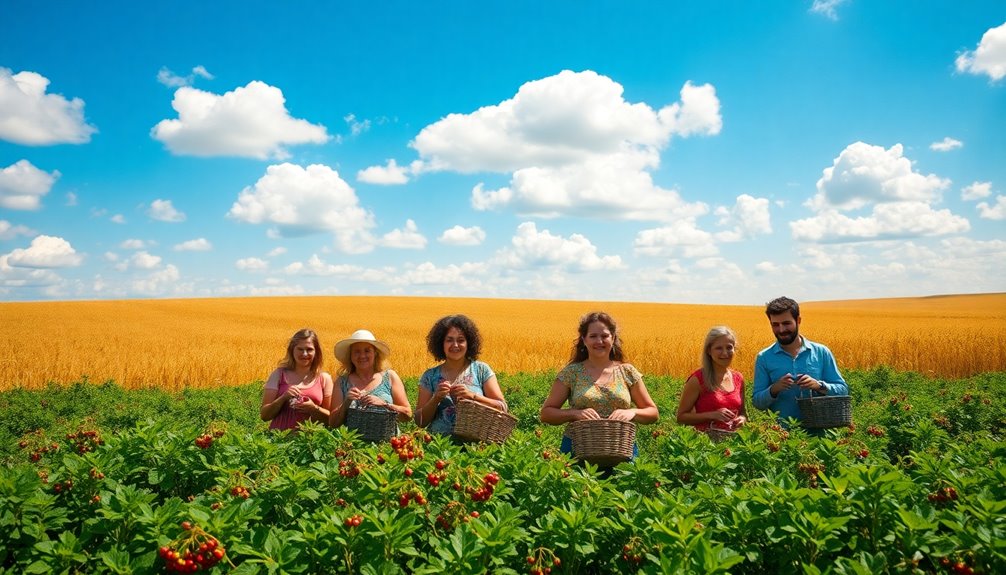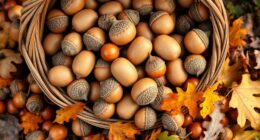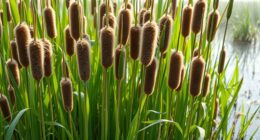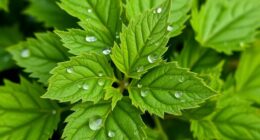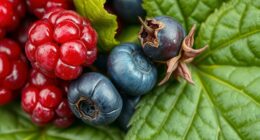Foraging means actively seeking and gathering wild food resources like plants, mushrooms, and game. It's a practice that connects you to nature and human traditions stretching back 250,000 years. This lifestyle promotes a nutrient-rich diet, encouraging physical activity and fostering community interactions. Foraging isn't just about survival; it also enriches cultural identities and supports ecological awareness. As you explore this age-old practice, you might discover its modern resurgence and how it shapes sustainable living today. If you're curious about the transformative power of foraging, there's a lot more to uncover about its benefits and significance!
Key Takeaways
- Foraging is the act of searching for and gathering wild food resources, such as plants, mushrooms, and game, essential for human survival for millennia.
- It predates agriculture and reflects human adaptability, with indigenous communities continuing traditional practices that preserve cultural connections to their ancestors.
- Foraging promotes a nutrient-rich diet and an active lifestyle, contributing to reduced chronic diseases and healthier eating habits compared to cultivated food reliance.
- It fosters sustainable resource management, supports biodiversity, and enhances ecological awareness, reducing the carbon footprint associated with industrial agriculture.
- The modern resurgence of foraging highlights a growing appreciation for sustainable living, with urban populations seeking fresh, organic options and engaging in community education.
Definition of Foraging
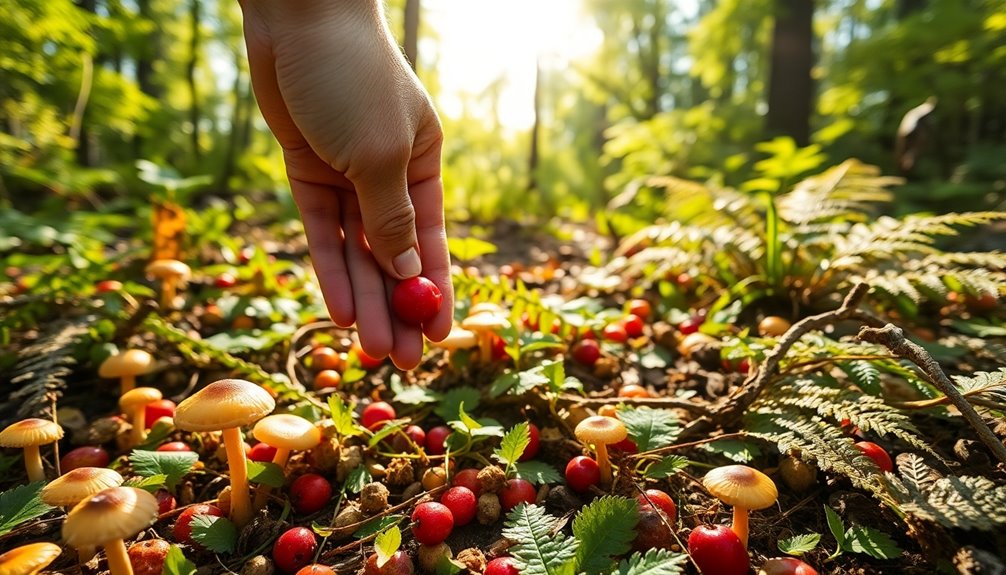
What does foraging really mean? Foraging is the act of searching for and gathering wild food resources, including plants, mushrooms, fruits, and even game. This definition highlights its essential role in human survival for thousands of years, long before agriculture took center stage.
By engaging in foraging, you embrace a practice that not only nourishes your body but also connects you deeply with your environment.
When you forage, you rely on your ability to identify edible plants and other resources, which fosters a greater appreciation for nature. This gathering method promotes nutrition and dietary diversity, as wild foods often pack more nutrients than their cultivated counterparts.
Plus, foraging encourages sustainable eating habits, supporting ecological balance and conservation efforts. Understanding the foraging range of different species can enhance your foraging experience and help you make informed decisions about where to look for food.
As you explore the wild, you'll discover that foraging isn't just about food; it's about understanding your surroundings and recognizing the bounty nature offers.
By practicing foraging, you engage in a time-honored tradition that emphasizes survival and the importance of biodiversity.
Historical Context
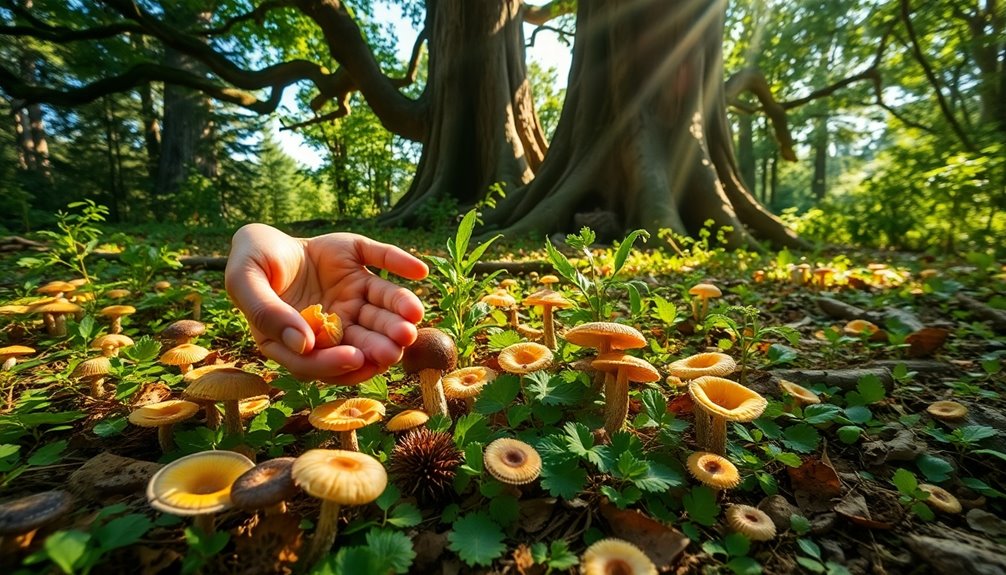
Foraging has shaped human history for tens of thousands of years, laying the groundwork for survival long before agriculture took hold. For around 250,000 years, foraging was the primary survival strategy, particularly flourishing in resource-rich areas.
The shift to agriculture, which took over 200,000 years, marked a significant change in resource acquisition methods. As the climate warmed at the end of the last ice age, groups began to adopt less mobile, sedentary lifestyles, leading some to embrace farming while others maintained traditional foraging practices.
Despite the rise of agriculture, many indigenous communities continue to practice foraging today, preserving cultural traditions that connect them to their ancestors.
This ancient lifestyle not only reflects a deep understanding of local ecosystems but also highlights the adaptability of humans in response to climate change. As societies evolved, the balance between mobility and resource acquisition shaped diverse ways of living.
Understanding this historical context enriches your perspective on foraging, illustrating its enduring importance in human history and its role in shaping the survival strategies of countless communities worldwide.
Characteristics of Foraging Communities
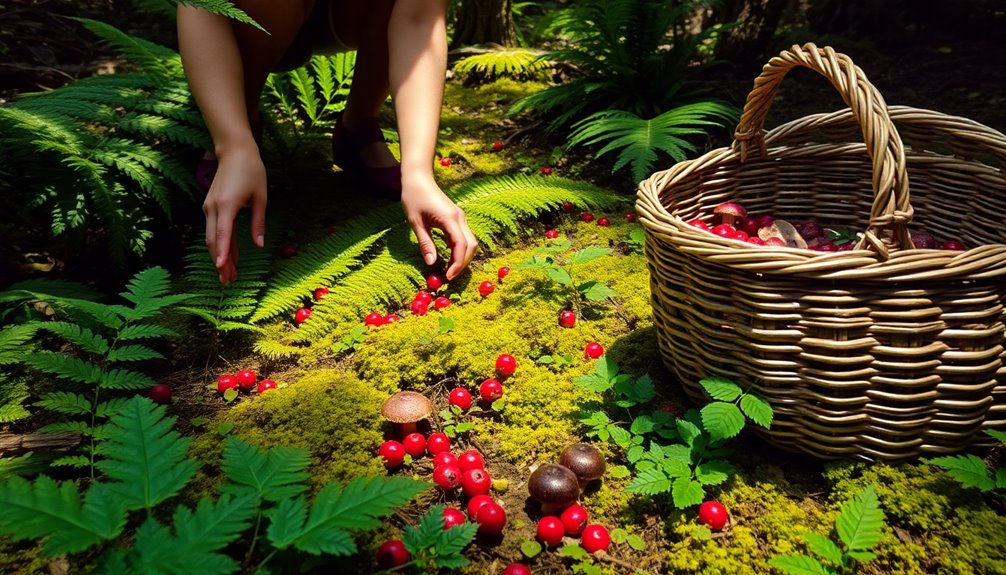
In foraging communities, you'll find that group sizes usually range from 20 to 50 individuals, which makes it easier to gather resources.
Gender roles are clearly defined, with men taking on hunting and women focusing on gathering, both being essential for the group's survival.
These dynamics create a unique social structure where age often dictates respect and authority, shaping how the community functions.
Group Size Dynamics
Small groups, typically between 20 to 50 individuals, define the dynamics of foraging communities, allowing for efficient resource management and mobility. These smaller group sizes enable you to adapt to your environment effectively. Larger groups may lead to competition for resources, making survival more challenging.
Within these communities, birth spacing plays an important role in maintaining mobility and efficiency in resource gathering. By limiting the number of dependent children, families can remain agile and responsive to changing conditions.
Social structures are often based on age dynamics, where older members earn respect and authority due to their experience in resource management and decision-making.
In foraging communities, gender roles are typically divided; men focus on hunting while women concentrate on gathering. However, both roles are equally essential for survival. This division of labor reflects the cooperative nature of foraging, where every member's contribution is crucial.
The interplay of group sizes, mobility, and age dynamics creates a cohesive environment, ensuring that foraging communities thrive while maintaining balance and harmony in their social structures.
Gender Roles in Foraging
Gender roles in foraging communities are characterized by a distinct division of labor that guarantees survival. Typically, men engage in hunting while women focus on gathering plant-based resources. Both roles are equally essential, ensuring the community thrives. In these groups, which usually consist of 20 to 50 individuals, cooperation between genders becomes vital for resource acquisition.
The social structures in foraging communities are largely based on age rather than wealth or strict gender hierarchies. Older individuals often command respect and authority, guiding the group in decision-making.
Birth spacing practices are influenced by the need for mobility during foraging, as limiting the number of dependent children helps the group remain agile.
Despite the division of labor, both genders contribute markedly to community well-being. The cooperation fostered between hunters and gatherers allows for successful foraging and resource sharing.
This interdependence not only strengthens the social fabric but also enhances the group's ability to adapt to changing environments. In understanding these gender roles, you gain a deeper appreciation for the intricate dynamics that sustain foraging communities.
Foraging Lifestyle and Health
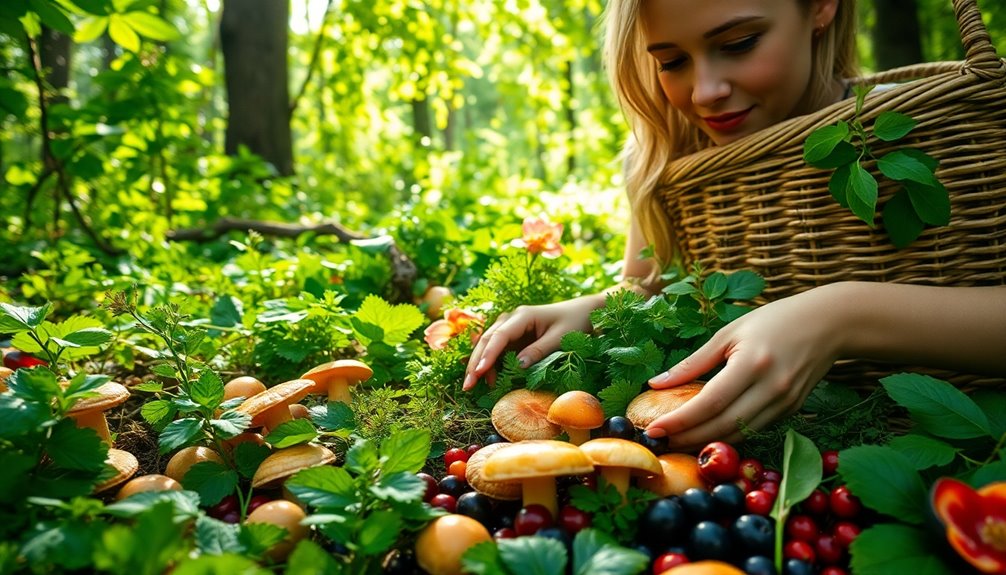
The foraging lifestyle offers a fascinating glimpse into a healthier way of living, emphasizing both physical activity and a diverse diet. Foragers typically worked only 4-6 hours a day, allowing ample leisure time for social interactions and community building. This lifestyle contrasts sharply with the sedentary agricultural approach, fostering stronger connections among individuals.
Their diets were nutrient-rich and diverse, leading to healthier eating habits compared to those reliant on cultivated foods. Although the average life expectancy for foragers ranged from 21 to 37 years, this shorter span reflects a connection between their active lifestyle and overall health, rather than indicating poor health. Foraging communities practiced birth spacing, which helped manage the number of dependent children and contributed to healthier population dynamics.
The physical activity inherent in foraging likely played a significant role in reducing chronic diseases, as foragers engaged in regular movement while searching for food.
Modern Resurgence of Foraging
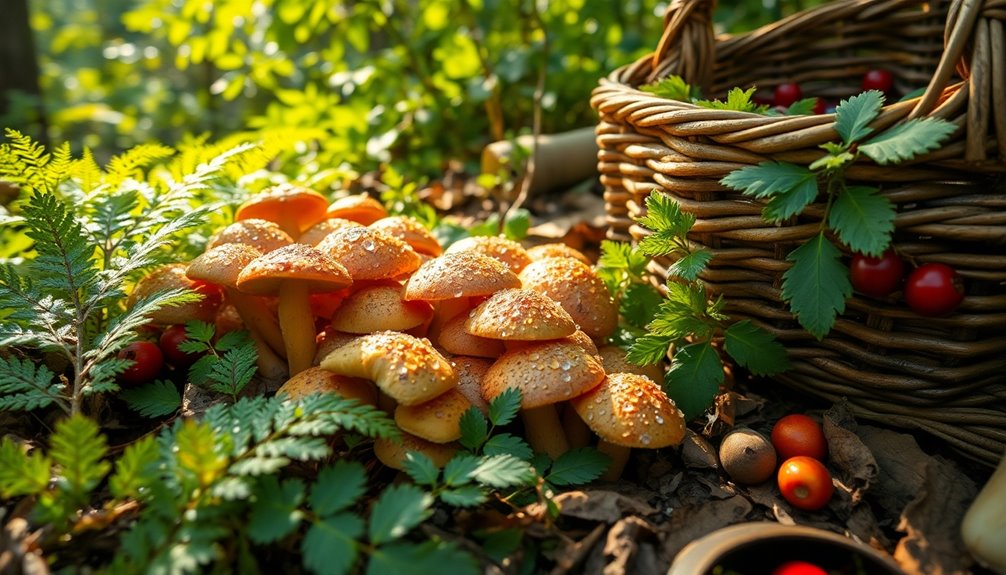
Foraging's modern resurgence reflects a growing appreciation for sustainable living and the desire to reconnect with nature. Urban populations are increasingly turning to wild edible resources, seeking fresh, organic options that supermarkets often can't provide. This revival isn't just about food; it's part of a broader cultural movement emphasizing ecological awareness and biodiversity. Embracing this lifestyle can also foster a growth mindset that encourages individuals to explore new skills and knowledge.
You might notice a rise in educational courses and workshops dedicated to foraging. These experiences help you learn traditional skills, fostering a deeper understanding of local ecosystems. Social media platforms further amplify this trend, allowing you to share your foraging adventures, tips, and knowledge with a community of enthusiasts dedicated to environmental conservation.
Moreover, foraging promotes health and wellness. By sourcing nutritious foods from nature, you often consume items that are far more beneficial than processed alternatives. In places like Minnesota, foragers can find a variety of wild edibles such as wild leeks and blueberries that enhance the foraging experience.
As you embrace responsible harvesting practices, you contribute to the sustainability of local ecosystems, ensuring that these wild resources remain available for future generations. This modern resurgence of foraging isn't just about filling your plate; it's about cultivating a lifestyle that respects the environment and enhances your well-being.
Ecological Impact of Foraging
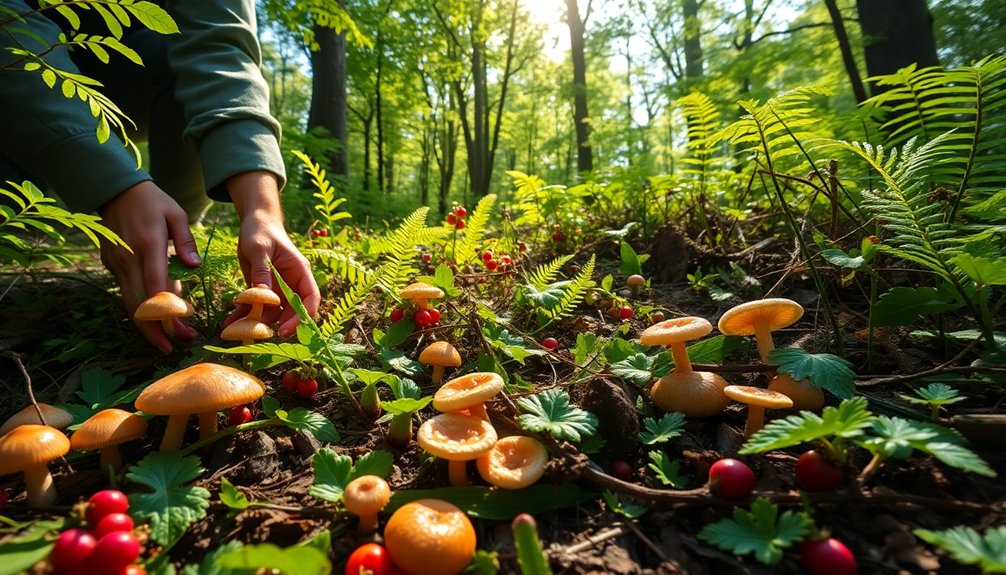
When you forage responsibly, you're not just gathering food; you're actively participating in sustainable resource management.
By embracing biodiversity preservation strategies, you help maintain healthy ecosystems that support local wildlife.
It's essential to understand the balance between enjoying nature's bounty and protecting it for future generations.
Sustainable Resource Management
Many people don't realize how foraging can play an essential role in sustainable resource management. By engaging in foraging, you actively promote biodiversity and conservation, enhancing awareness of local flora. This practice encourages sustainable harvesting, which minimizes ecological impact and supports healthy local ecosystems. Additionally, understanding herbal remedies can further enrich your foraging experience by highlighting the uses of various plants. Foraging can also lead to a greater appreciation of local ecosystems and their intricate relationships, especially when you consider the importance of forage quality testing in determining the viability of harvested plants. Moreover, foraging can provide insights into best survival gear that can be utilized during outdoor adventures.
Here's a quick overview of how foraging contributes to sustainable resource management:
| Aspect | Benefits | Responsible Practices |
|---|---|---|
| Biodiversity | Supports diverse plant species | Only take what's necessary |
| Resource Depletion | Prevents overexploitation | Respect seasonal availability |
| Carbon Footprint | Reduces reliance on industrial agriculture | Forage locally for wild foods |
| Community Stewardship | Fosters connection to nature | Educate others about responsible foraging |
When you adopt responsible foraging techniques, you help maintain ecological balance and prevent resource depletion. This practice deepens your connection to the natural world, encouraging community stewardship. By choosing wild foods, you lower your carbon footprint, contributing to a healthier planet. Embracing foraging can truly change your perspective on sustainability and resource management. Additionally, foraging can promote mental stimulation for various wildlife, further enhancing the ecological benefits of this practice.
Biodiversity Preservation Strategies
Engaging in foraging not only connects you with nature but also plays an essential role in biodiversity preservation strategies. By practicing responsible foraging, you contribute to sustainable harvesting and help maintain healthy ecosystems. This not only supports genetic diversity within species but also preserves native flora and fauna.
Here are a few key benefits of foraging for biodiversity:
- Enhanced Ecological Awareness: You develop a deeper understanding of local ecosystems and food webs, which helps you appreciate the intricate balance of nature.
- Promoting Stewardship: By advocating for conservation efforts, you foster a sense of responsibility for the land and its resources, ensuring they're available for future generations.
- Community-Based Initiatives: Engaging in local foraging groups allows you to learn from others while promoting ecological education and sustainable practices.
Through these actions, you can make a significant impact on biodiversity. By understanding the importance of your food choices and their ecological effects, you become an active participant in the conservation of natural habitats.
Foraging in Animal Behavior
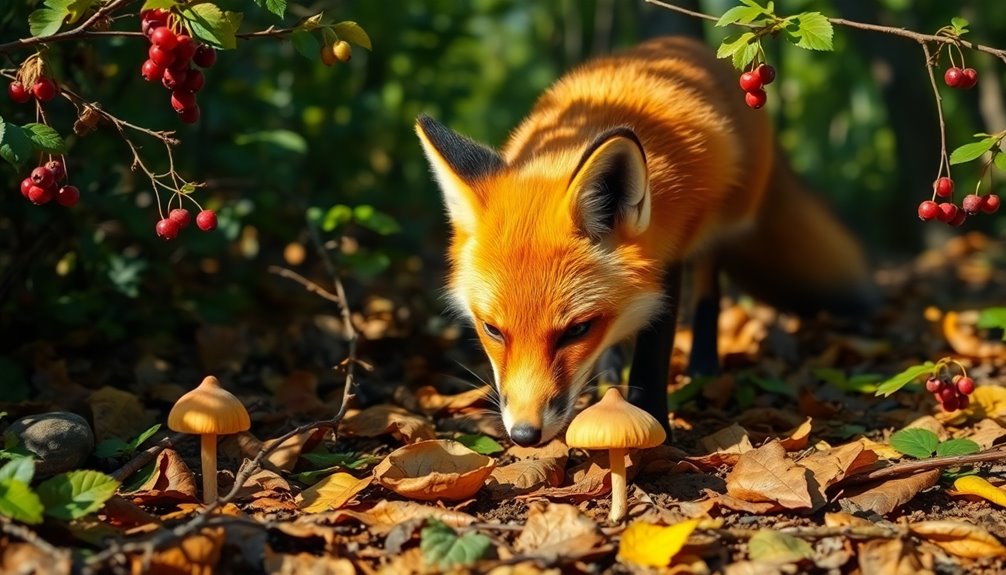
Foraging in animal behavior is a vital survival strategy, where animals actively search for, identify, and obtain food from their environment. This behavior involves complex decision-making influenced by various factors like prey availability and competition. Animals adopt adaptive strategies, such as solitary foraging and group foraging, to optimize their energy intake.
| Foraging Type | Benefits | Drawbacks |
|---|---|---|
| Solitary Foraging | Minimizes competition; efficient for certain species | Limited access to food resources |
| Group Foraging | Enhances success through cooperation | Increased competition for limited resources |
| Adaptive Strategies | Tailored approaches based on environmental conditions | May not always maximize energy intake |
| Learning | Young animals mimic elders, improving foraging skills | Requires time and observation to master |
Optimal foraging theory suggests that animals will choose strategies that maximize their energy intake while minimizing energy expenditure. However, real-world situations often complicate this, with environmental factors and social dynamics affecting their choices. This intricate balance illustrates the significance of foraging behavior in ensuring survival and reproduction in the animal kingdom.
Cultural Significance of Foraging
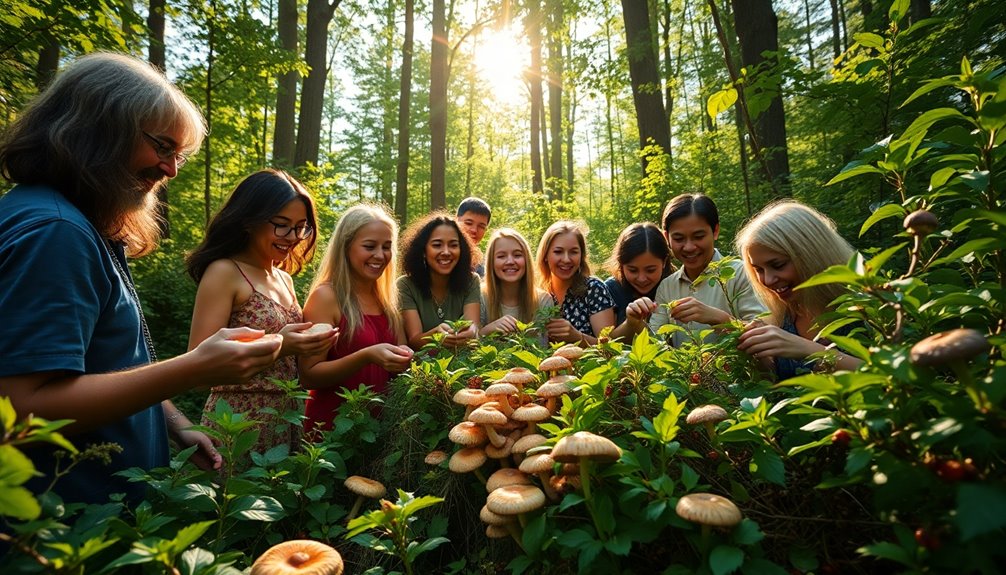
The practice of foraging has shaped human cultures for thousands of years, serving as the primary means of obtaining food long before agriculture took hold. This ancient method not only influenced dietary practices but also played a vital role in the social structures of communities.
In foraging societies, you'll find that cooperation and respect for elders often took precedence over wealth, fostering communal resource sharing and strengthening community dynamics.
Foraging also carries rich cultural significance, as seen in various practices and gatherings that help transmit traditional ecological knowledge. Here are a few key aspects:
- Sustainable food sources: Foraging encourages a deep connection to the land, promoting environmental stewardship.
- Indigenous societies: Many continue to rely on foraging, reflecting their cultural heritage and history.
- Cultural practices: Rituals and gatherings around foraging reinforce bonds within the community.
As you explore foraging today, especially in urban settings, you'll notice a resurgence of interest in local food sources, emphasizing sustainability and community engagement.
Frequently Asked Questions
What Is the Meaning of Foraging?
Foraging means searching for and gathering wild food resources, like plants, mushrooms, and fruits.
You explore nature, discovering edible treasures that have sustained humans for ages.
It's not just about finding food; it's a connection to the land and its biodiversity.
By foraging, you engage in a sustainable practice that nurtures your health and well-being while enhancing your awareness of local ecosystems.
It's a rewarding way to enjoy nature and its offerings.
What Is the Definition of These Terms Foraging?
So, you think foraging's just a hipster's excuse to rummage through the woods, huh?
Well, it's actually the art of hunting down wild edibles—think fruits, nuts, and maybe even a mushroom or two for your next Instagram post.
It's about knowing what's in season and what won't send you running to the ER.
What Is Foraging in Psychology?
In psychology, foraging refers to how you and other animals strategize to find and obtain food. You weigh factors like resource availability and competition, much like making economic choices.
Social influences are key too; you might learn foraging skills from peers or mentors. Additionally, the presence of predators forces you to evaluate risks and benefits, shaping your decisions about what and how to forage effectively.
This understanding can enhance insights into human behavior in various contexts.
What Is the Definition of Human Foraging?
Imagine wandering through a vibrant forest, where each step reveals treasures hidden beneath leaves and branches.
Human foraging is the art of seeking and gathering wild food—plants, mushrooms, fruits, and more—that nature provides.
It's an age-old skill, rooted in our survival instincts. You're not just collecting; you're connecting with the earth, rediscovering flavors and stories that have nourished humanity for millennia.
It's about embracing the bounty that surrounds you.
Conclusion
In a world buzzing with convenience, think of foraging as your personal treasure hunt. Just like a child discovering hidden gems in their backyard, you can unearth nature's bounty right outside your door. Studies show that foraging not only connects you to the environment but also boosts your well-being. So, next time you stroll through a park, remember: nature's pantry is waiting for you, filled with flavors and stories that can transform your perspective on food and life!

